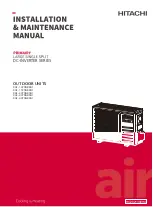
危
险
!
CAUTION
·
Air
Tight Check - Do use Nitrogen.
6. Vacuum Pumping and Refrigerant Charge
·
Vacuum
Pumping
Air Tight Procedure
Completion
of
Ref
.
Piping
Repairing
of
Leakage
Part
Check
of
Pressure
Decrease
Applying
Nitrogen
Gas
Pass
Procedure
Connect the gauge manifold using charging hoses with a nitrogen
cylinder to the check joints of the liquid line and the gas line stop
valves.
Perform the air tight test.
Don't open the gas line stop valves.
Apply nitrogen gas pressure of 550 psig (3.8 MPa).
Check for any gas leakage at the flare nut connections, or brazed
parts by gas leak detector or foaming agent.
Gas pressure doesn’t decrease, which is OK.
After the air tight test, release nitrogen gas.
·
An
excess
or
a
shortage
of
refrigerant
is
the
main cause
of
trouble
to
the
unit
.
Charge
the
correct
quantity
of
refrigerant
according to
the
description
in the
manual
.
·
Check
for
refrigerant
leakage
in
detail
.
If
a
large refrigerant
leakage
occurs
,
it
will
cause
difficulty in
breathing
or
harmful
gases
would
occur
if
a fire
is
being
used
in
the
room
.
Charge hose
(for R410A)
Installation instructions
Piping insulation procedure
Insulation
(
)
field-supplied
(6) After finishing connecting the refrigerant pipes, keep it warm with
the insulation material.
·
For outdoor unit side, surely insulate every piping including valves.
·
Cover piping joints with pipe cover.
·
Using piping tape, apply taping starting from the entry of outdoor unit.
-
Fix the end of piping tape with adhesive tape.
-
When piping has to be arranged through above ceiling, closet or area
where temperature and humidity are high, wind additional commercially
sold insulation for prevention of condensation.
5. Air
Tight Test
Clamp (field-supplied) Insulation (field-supplied)
Refrigerant pipe
(field-supplied)
(1) Remove the service port cap of the stop valve on the gas pipe
side of the outdoor unit.
(2) Connect the manifold gauge and vacuum pump to the service port
of the stop valve on the gas pipe side of the outdoor unit.
(3) Run the vacuum pump. (Work for more than 15 minutes.)
(4) Check the vacuum with the gauge manifold valve, then close the
gauge manifold valve and stop the vacuum pump.
(5) Leave it as is for one or two minutes. Make sure that the pointer of
the manifold gauge remains in the same position. Confirm that the
pressure gauge shows -14.7psig (-0.101MPa or -760mmHg).
(6) Remove the manifold gauge quickly from the service port of the
stop valve.
(7)
After refrigerant pipes are connected and evacuated, fully open
all stop valves on both sides of gas pipe and liquid pipe.
(8) Open adjusted valve to add refrigerant
(
the refrigerant
is
liquid
).
(9) Tighten the cap to the service port .
(10) Retighten the cap.
(11) Leak test foam with halogen leak detector to check the flare nut
and brazing Carolina Department leaks. Use foam that does not
generate ammonia (NH3) in the reaction.
8
Indoor unit
Outdoor unit
Manifold
valve
Pressure
gauge
Vacuum
pump


































